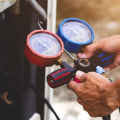The oven and fan motor are two of the main components of a home HVAC system. The oven is quite large and usually requires its own space in the basement, attic, or closet. A fuel source (typically natural gas, oil, or electricity) heats the incoming air. The main unit of an HVAC system includes the air conditioner, heat pump, or furnace.
These are the parts where your home is heated and cooled, but they do so with the help of other internal and external mechanisms. This is the KEY and largest component of your HVAC system and requires a lot of space, usually in the basement, attic, or designated closet. The duct system that transports the air heated or cooled by the system to the different areas of your home is called Ductwork. Conduits are usually made of lightweight aluminum, but can also be made of steel, flexible plastic, polyurethane, fiberglass, or fabric.
The heat exchanger is located inside the heating unit housing and turns on when the thermostat activates the oven to produce warmer temperatures in winter. It draws cold air, heats it up and circulates the resulting warm air through the ducts and out through the vents. The evaporator coil cools the air when the thermostat is set to lower temperatures in summer. It has the opposite function to that of the heat exchanger and is located in a metal housing on the outside of the oven (top or side).
The coil works like a car radiator to produce cold air that circulates through the ducts. The biggest enemy of your home's heating and cooling system is dirt. It can dramatically reduce efficiency and waste fuel. Cleaning is the most important part of regular maintenance because it affects every component of the system.
Belt adjustment and lubrication in the oven are also important. To keep your heating and cooling systems in optimal condition, have them serviced by a professional at least once a year. The best time to repair an oven is at the end of the heating season and have your air conditioner checked at the same time. Every HVAC system contains six main parts that it needs to operate: an oven, fan motor, ductwork, heat exchanger, evaporator coil, and thermostat.
When one or more of these parts stop working properly, there are problems that range from uneven temperature distribution to poor air flow. The job of an HVAC technician is to listen to customers, identify their problems, and diagnose system problems which parts of the system are most likely to cause problems. The ventilation mechanism of an HVAC is responsible for moving hot or cold air in and out of your home. Rising utility costs mean that new HVAC systems must be optimized in terms of cost and efficiency, and deliver the same results with less energy and money.
If an evaporator is frozen, damaged, or dirty, an HVAC system can stop heating and cooling or work hard to produce poor results. A-1 Heating Air Conditioning & Electric specializes in everything related to HVAC systems and will gladly help you if you have any problems with your equipment. When an HVAC system is configured to heat up, the furnace air is ignited with combustible material to produce heat to heat the air. However, a heating, ventilation and air conditioning system not only controls temperature but also helps circulate fresh air, filter pollutants from the air and conserve energy.
In general, more than one thermostat is installed in different zones in some HVAC systems such as those that are divided into zones. Among the various parts of your HVAC system, a thermostat is one of the most visible in the home. With proper preventive maintenance many of these air conditioning repairs can be prevented, detected early and addressed before you run out of air conditioning in mid-summer. So what are all these main components that make up a heating ventilation and air conditioning (HVAC) system? In this comprehensive guide we'll explore all six key parts that make up an HVAC system: ovens/furnaces; fan motors; ductwork; heat exchangers; evaporator coils; and thermostats - as well as how each one contributes to creating a comfortable environment for you and your family.
It's increasingly common to see HVAC spelled as HVACR which expands its original definition to include refrigeration.



